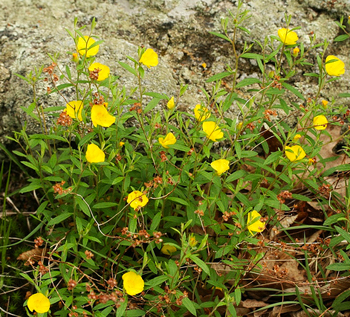Contents:
Common Names | Parts Usually Used | Plant(s) & Culture | Where Found | Medicinal Properties
Uses | Formulas or Dosages | Bibliography
Scientific Names

- Helianthemum canadense L.
- Cistaceae
- Rock-rose family
Common Names
- Frost plant
- Frost weed
- Frostwort
- Scrofula plant
- Sun rose
Parts Usually Used
The whole plant, oil of the plant
Back to Top
Description of Plant(s) and Culture
Rock-rose is a native North American perennial plant, 6-20 inches tall; the unbranched, downy stem bears alternate, linear-oblong, toothless leaves, 1/2 to 1 inch long and about 1/4 as wide, which are dark green above and downy white beneath. The plant flowers twice in a season: the first solitary flowers with many stamens are bright yellow and have large petals that drop a day or so after opening; later another set of inconspicuous flowers develop, without petals and few stamens, growing in axillary clusters. Blooms May to July. The whole plant has a slight aromatic odor, and an astringent and bitter taste.
Back to Top
Where Found
Found in dry, sandy soils and rocky woods in the United States can be found as far south as North Carolina and Mississippi and as far west as Illinois and Wisconsin. Also found in Quebec.
Back to Top
Medicinal Properties
Alterative, aromatic, astringent, tonic
Back to Top
Uses
Used relatively little, at least alone. Can be used for diarrhea, mouth, scarlatina, and throat irritations, and skin problems. Has been used at times as an eyewash. In large doses it acts as an emetic.
Native Americans used leaf tea for kidney ailments, sore throats. Patients were covered with a blanket “tent” to hold steam; feet soaked in hot tea for arthritis, muscular swellings, and rheumatism. Historically, physicians once used a strong tea for scrofula(tuberculous swelling of lymph nodes), for which it was reported to produce astonishing cures; also diarrhea, dysentery, gonorrhea, and syphilis. Externally, used as a wash for skin diseases such as prurigo, and eye infections; gargled for throat infections. Leaves poulticed on scrofulous tumors, sores, and ulcers; said to be helpful in treatment of some forms of cancer.
Back to Top
Formulas or Dosages
Infusion: steep 1 tsp. herb in 1 cup hot water for 10 minutes. Take 1 tbsp. 3 to 6 times per day.
Tincture: a dose is from 5 to 10 drops
Back to Top
Bibliography
![]() Eastern/Central Medicinal Plants
Eastern/Central Medicinal Plants, by Steven Foster and James A. Duke., Houghton Mifflin Company, 215 Park Avenue South, New York, NY 10000
![]() The Herb Book
The Herb Book, by John Lust, Bantam Books, 666 Fifth Avenue, New York, NY. copyright 1974.
![]() Back to Eden
Back to Eden, by Jethro Kloss; Back to Eden Publishing Co., Loma Linda, CA 92354, Original copyright 1939, revised edition 1994
![]() Indian Herbalogy of North America
Indian Herbalogy of North America, by Alma R. Hutchens, Shambala Publications, Inc., Horticultural Hall, 300 Massachusetts Avenue, Boston, Massachusetts 02115, 1973
![]() Webster’s New World Dictionary
Webster’s New World Dictionary, Third College Edition, Victoria Neufeldt, Editor in Chief, New World Dictionaries: A Division of Simon & Schuster, Inc., 15 Columbus Circle, New York, NY 10023
